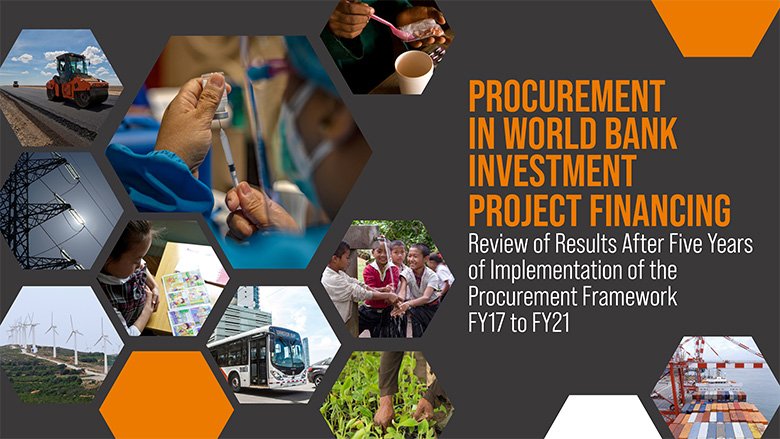For over 50 years, the World Bank’s Procurement guidelines had served as an international model in public procurement rules among Multilateral Development Banks (MDBs). In 2016, after detailed review and analysis, the Bank launched a new Procurement Framework (Framework) to advance Bank procurement policy to encourage a more “fit-for-purpose” procurement approach and enhance value for money for borrowers. Management agreed, when seeking Board approval of the new Procurement Policy in 2015, that “a formal, detailed review of the entire Framework…” should be undertaken after five years of implementation to assess whether the Framework has been implemented successfully and has improved procurement results. The introduction of the Framework and its supporting Information Technology (IT) systems, particularly the Systematic Tracking of Exchanges in Procurement (STEP), has significantly improved efficiency of procurement actions and Management’s ability to monitor this and other intended objectives of the reform. This paper provides a five-year retrospective on the results of implementation of the Framework, which became operational on July 1, 2016.
Benefits of the Procurement Framework:
As noted in this retrospective report, implementation of the Framework has delivered significant benefits and improved results for numerous Bank stakeholders. Some of the benefits outlined in the report include:
- Application of “fit-for-purpose” procurement approaches by borrowers—by encouraging a more strategic approach to procurement, borrowers are now able to attract the right bidders, achieve better project outcomes, and maximize Value-for-Money (VfM).
- Introduction of innovative approaches to proactively support borrowers—the Framework promoted use of new approaches such as Hands-on Extended Implementation Support (HEIS) and Bank Facilitated Procurement (BFP) to directly assist borrowers in their procurement efforts when they are faced with capacity, market, or supply obstacles. Both HEIS and BFP proved especially effective as part of the Bank’s COVID-19 pandemic response.
- Increased competition for Bank financed projects—from FY2017 to FY2021, new market entrants (i.e., bidders who bid for a World Bank contract for the first time) made up 77% of all contracts by monetary value and 78% of all suppliers.
- Introduction of the “STEP” procurement information system—launch of the Bank’s IT system to support procurements (STEP) has contributed to better procurement efficiency yielding an annual compounded 7% decrease in median procurement time to complete a transaction.
- Enhanced gains in Fragile, Conflict, and Violence (FCV) environments—the Framework has proven particularly beneficial to FCV borrowers who have seen an overall annual compounded decrease of 9% in median procurement time to complete a transaction.
World Bank Management Commitment:
In addition to marking the significant progress over the five-year period of review, the report also proposes a plan of action for future Framework improvements. Based on its experiences over the past five years, Management has committed to:
- Further strengthen Borrower use of Value for Money award decisions—Bank procurement staff will scale-up training and HEIS support to accelerate borrowers use of quality-based rated evaluation criteria and life-cycle cost analytics in their award decisions.
- Evaluate the overall effectiveness of Value for Money in Bank financed procurement—Management will develop clear indicators to track whether VfM is being achieved.
- Improve management and mitigation of cybersecurity risks—Management will require borrowers to assess cybersecurity risks and establish risk mitigation criteria to be used in award decisions.
- Launch enhanced contract management support and integrity—A new upgrade to the contract management system will support better monitoring of Key Performance Indicators (KPIs) for large contracts and will enhance Bank and Borrower teams’ overall ability to track project implementation timelines and outcomes.
- Applying the SEA/SH disqualification mechanism. Closely monitor the implementation of the SEA/SH disqualification mechanism and update on progress with implementation and its impact.
- Strengthen supply chain management, security, and resilience—Bank procurement staff will expand the Framework’s toolbox to help borrowers and bank teams build supply chain resiliency and better manage the risks of sudden supply chain disruptions. Bank staff will produce technical guidance and capacity building tools to help with supply chain mapping, risk analysis, traceability protocols, quality inspection and testing, cost benchmarking, and logistics management.
- Continuing to support public procurement reforms and capacity building in Borrower countries. Policy dialogue and technical assistance will continue to include broad systemic reforms and discrete interventions to strengthen individual institutions. These efforts will include a deeper focus on the areas included in this action plan such as, for example, green/sustainable procurement, working with Supreme Audit Institutions to modernize fiduciary control frameworks in ways that support VfM decision-making, and developing effective emergency procurement approaches.
- Operationalizing mandatory direct payment. Based on the successful pilot, this requirement will be mainstreamed for all procurements in FCV environments except when Borrowers prefer to pay national suppliers from dedicated project accounts.
- Operationalizing Beneficial Ownership. Consistent with good international practice and the pilot’s success, this requirement will be mainstreamed and extended to all internationally advertised contracts (for which the specific procurement notice is published on or after July 1, 2022).
